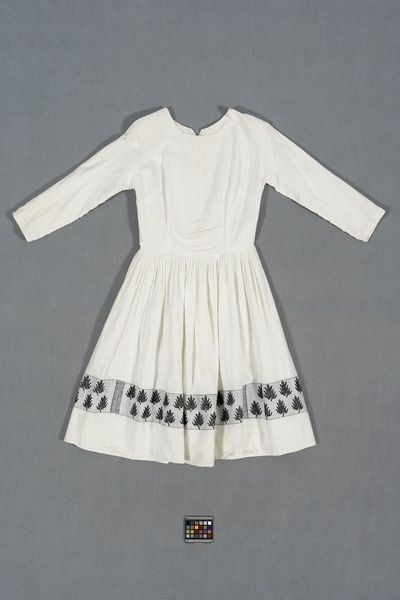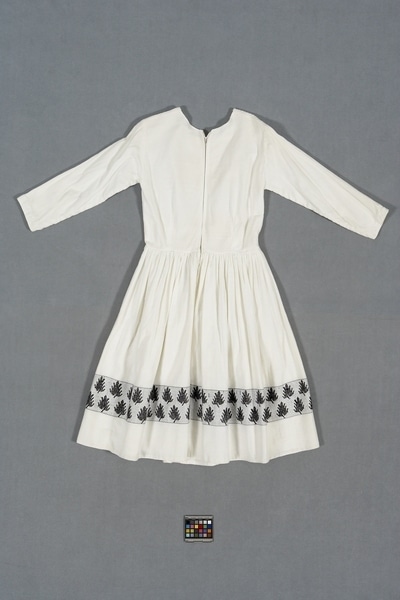Dress Item Number: Ca36 a from the MOA: University of British Columbia


Description
White cotton dress with a rounded neck, long sleeves, a fitted bodice and gathered waist. The full skirt is made of three panels and reaches mid-calf in length. The dress has a long metal zipper down the back and is lined with commercial cotton. Along bottom of the skirt is a white and black border with multicoloured metallic detailing. The border has a black oda tree motif arranged in a staggered double row. Matching shawl (Ca36 b).
History Of Use
Women's national dress (parts a and b) made from hand woven cotton; women spin the cotton and men usually do the weaving. Dresses are made to order. Traditionally dresses were plain white, and border patterns were never repeated. The coloured threads on this dress are a newer addition. Modern versions of the dress are worn for holidays and special occasions. The style of embroidery, specifically the oda trees, indicates that the clothing is likely from the Oromo people, although white cotton clothing can be found throughout Ethiopia. The weaving techniques and embroidery used in Ethiopian textiles are reminiscent of early cultural exchange and trade between Ethiopia and its neighbouring countries. Records show that as early as the first century CE, cotton was being imported into Ethiopia via the Red Sea. For the first few centuries, cotton clothing was restricted to aristocracy, but over time it became prolific throughout Ethiopian society.
Item History
- Made in Ethiopia before 1974
- Collected during 1974
- Owned by Lemma Admasu before December 27, 1979
- Received from Lemma Admasu (Seller) and Museum of Anthropology Donations Fund (Funding source) on December 27, 1979
What
- Name
- Dress
- Identification Number
- Ca36 a
- Type of Item
- dress
- Material
- dye, metal and cotton fibre
- Manufacturing Technique
- woven, dyed and machine stitched
- Overall
- height 105.0 cm, width 53.0 cm
Who
- Culture
- Oromo ?
- Previous Owner
- Lemma Admasu
- Received from
- Lemma Admasu (Seller) and Museum of Anthropology Donations Fund (Funding source)
Where
- Holding Institution
- MOA: University of British Columbia
- Made in
- Ethiopia
When
- Creation Date
- before 1974
- Collection Date
- during 1974
- Ownership Date
- before December 27, 1979
- Acquisition Date
- on December 27, 1979
Other
- Item Classes
- textiles
- Condition
- good
- Accession Number
- 0587/0004 a